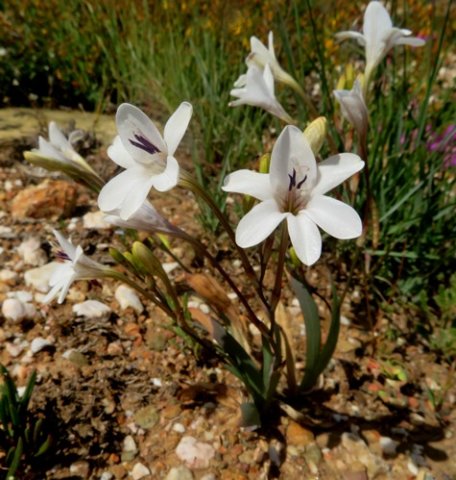Tritonia

Author: Ivan Lätti
Photographer: Thabo Maphisa
Tritonia is a genus of cormous, deciduous perennials in the Iridaceae family.
The Afrikaans common name of agretjie is derived from the French word, aigrette, referring to the plume-shape of some inflorescences. The generic name, Tritonia is derived from Triton, a demigod, son of Poseidon, also a Latin word, triton, meaning a weathercock, referring to the variable positions of the stamens of some of the flowers of these plants.
The globose to conic corms grow roots below and are covered in coarse to finely fibred tunics. There is sometimes a fibrous neck around the base of the stem. The stems are cylindrical and sometimes short or branched.
Several leaves are grown, often in a closely set fan, the lowest two or three being cataphylls. Leaf-shape varies from linear or cylindrical to ovate or sword-shaped. The leaf margins may be crisped, rolled in or winged and the midrib thickened. Stem-leaves are few and small.
The inflorescence is a one- to many-flowered spike, sometimes secund (flowers facing one way) or spiralling. The floral bracts are small, firm and green or membranous and dry, often three-toothed. The inner bract is usually smaller than the outer one.
The flowers are usually laterally symmetrical and funnel-shaped, salver-shaped or radially symmetrical, their tubes long or short. The flowers bear nectar and many species exude a sweet fragrance. When tepals are unequal, the dorsal one is biggest. Yellow and orange are common corolla colours, red and pink less so. Dark(er) tepal venation is often present.
There are three stamens in each flower, their filaments attached at the base of the throat. The style is sometimes exserted, its three short branches slightly flattened and recurved.
The fruit capsules are cartilaginous, ellipsoid to globose. The seeds are spherical or flattened and sometimes smooth.
There are 28 species of Tritonia, all in eastern and southern Africa. Several of them occur in the western winter rainfall region of South Africa.
The plant in picture is Tritonia gladiolaris (Leistner, (Ed.), 2000; Manning, 2009; Pooley, 1998; Andrew, 2017).

